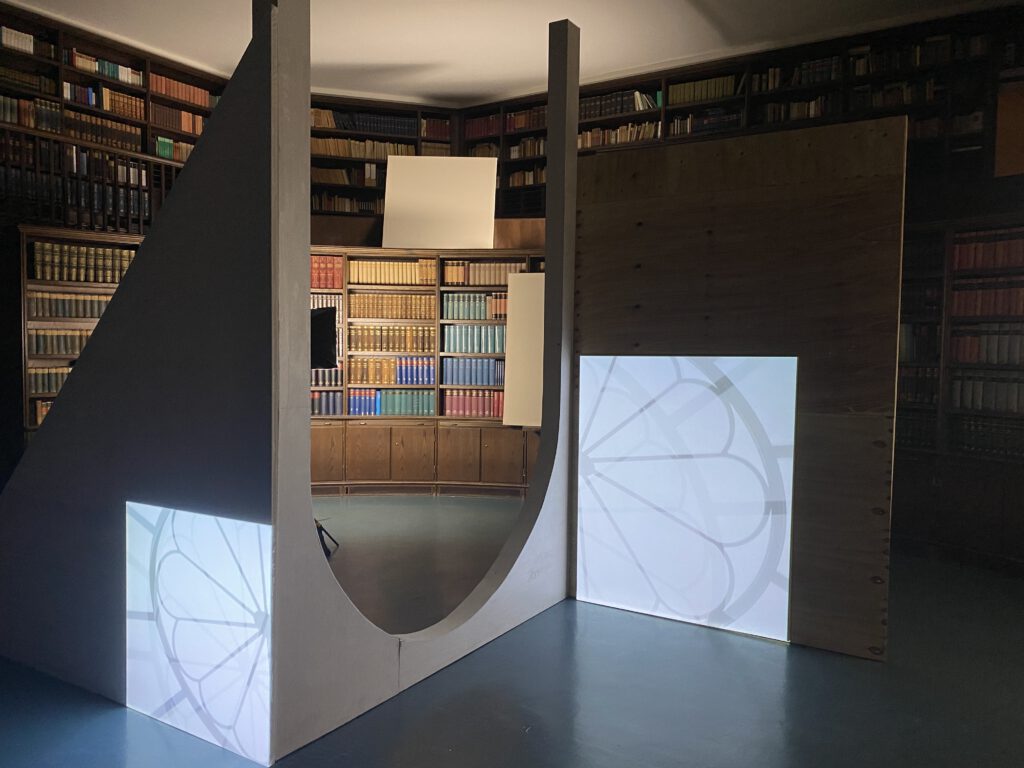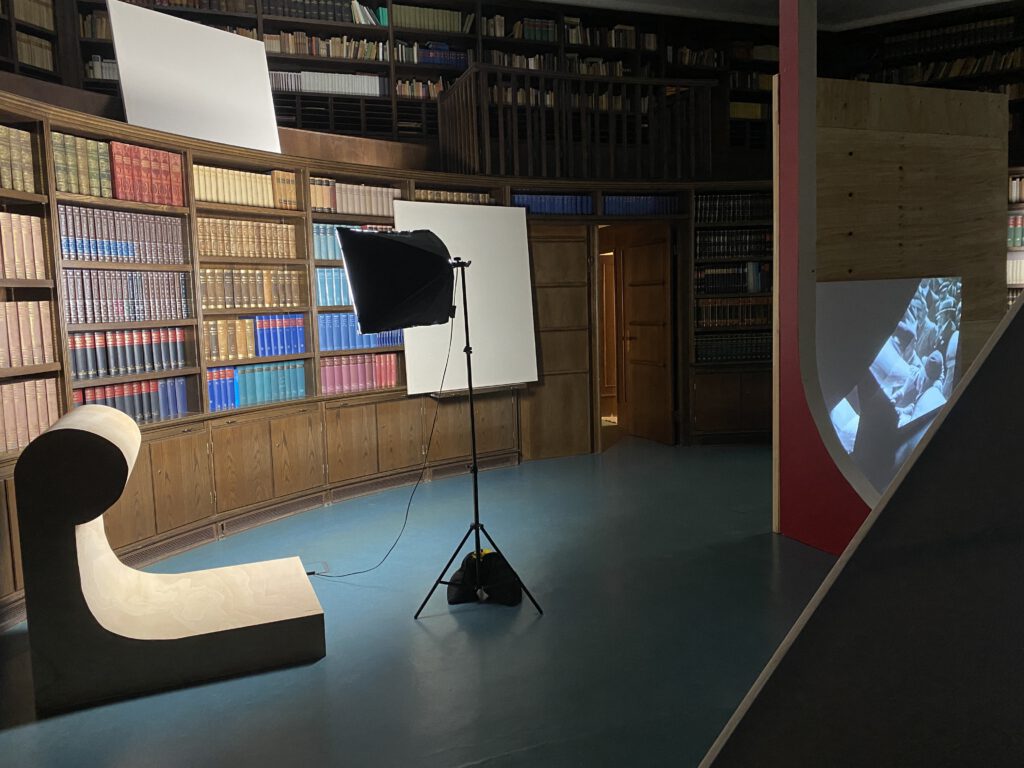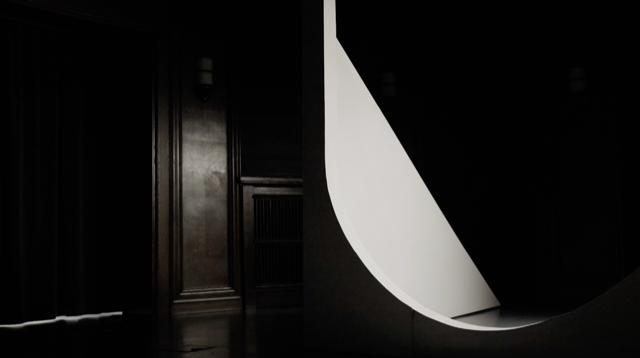mit Tillmann Terbuyken
Künstlerische Intervention im Lesesaal der Kulturwissenschaftlichen Bibliothek Warburg (K.B.W.) | Warburg-Haus Hamburg
(English Version below)
Das heutige Warburg-Haus Hamburg und dessen Lesesaal, der seit seiner Eröffnung im Jahr 1926 als Nukleus der Kulturwissenschaftlichen Bibliothek Aby Warburgs (K.B.W.) den unterschiedlichsten Nutzungen wie Einschreibungen unterlag, wird zum Ausgangspunkt einer filmisch-installativen Intervention von Eske Schlüters und Tillmann Terbuyken.
In künstlerischer Kooperation aktivieren sie die architektonische Hülle der ehemaligen K.B.W. als temporären Aufführungsraum, in dem Visionen von vergangenen Zukünftigkeiten und aktuelle Zeitgeschichte miteinander verschmelzen. In einer Stellprobe experimentierten Terbuyken und Schlüters im Vorfeld mit Projektionen und skulpturalen Objekten im Raum, die das Zentrum des elliptischen Lesesaals okkupieren. Leere Leinwände im Format der von Warburg konzipierten Mnemosyne-Tafeln seines Bilderatlas und arrangierte Sperrholzobjekte, als auch der Lesesaal an sich werden zum Bildträger: Durch Kamera- und Spiegelbewegungen entsteht ein Raum-Zeit-Gefüge, das sich rekursiv mit dem Anfang des 20. Jahrhunderts verschränkt und das Recherchefeld von Schlüters und Terbuyken darstellt. So falten sich Bild- und Raumachsen derart ineinander, dass ein visuelles Dispositiv multikausaler An- und Abwesenheiten entsteht.
Im dem im Raum als Spitscreen projizierten Video Shell Script Memory Simulator Program, in dem es im Rückgriff auf die Entstehungszeit des Ortes um eine Reflexion von Erinnerung, Geschichtsschreibung und Handlungsspielräumen gegen autoritäre Regime geht, kommen KI-basierte Text-to-Speech Programme für eine techno-poetologische Soundspur zum Einsatz, während die Bildspur aus selbstgedrehtem Material von analog erstellten Filmtricks aus den Anfängen des Kinos besteht: das Schüfftan-Verfahren. Es wurde erstmals für Metropolis (1927) eingesetzt und ist ein Spiegeltrick, durch den verschiedene Räume und Zeiten miteinander zur Verschmelzung gebracht werden können.
Gefördert von der Behörde für Kultur und Medien der Freien und Hansestadt Hamburg


Unpredictable Journeys into the Interior of Time (with Tillmann Terbuyken)
Today’s Warburg-Haus Hamburg and its reading room, which since its opening in 1926 as the nucleus of Aby Warburg’s Kulturwissenschaftliche Bibliothek (K.B.W.) has been subject to a wide variety of uses and inscriptions, becomes the starting point for an artist intervention by film-maker Eske Schlüters and installation artist Tillmann Terbuyken. In an artistic cooperation, they activate the architectural ’shell‘ of the former K.B.W. as a temporary performance space in which visions and ideas of past futures and contemporary history merge.In a rehearsal, Terbuyken and Schlüters experimented in advance with film projections and sculptural objects at site. So the objects and projections occupied the elliptical reading room which forms the centre of the whole building. Empty canvases – in the same format of the Mnemosyne-panels of Warburgs Bilderatlas – and arranged plywood objects, as well as the reading room itself, become image carriers for film projections: As such, images of camera and mirror movements create a space-time structure that recursively intertwines with the beginning of the 20th century and represents Schlüters‘ and Terbuyken’s field of research. Image and spatial axes fold into each other in such a way that a visual dispositif of multi-causal presences and absences emerges.
In the video Shell Script Memory Simulator Program, which is projected in the space as a spitscreen and, with recourse to the time when the location was created, deals with a reflection on memory, historiography and the scope for action against authoritarian regimes, AI-based text-to-speech programs are used for a techno-poetological soundtrack, while the image track consists of self-shot material from analog film tricks from the early days of cinema: the Schüfftan process. It was first used for Metropolis (1927) and is a mirror trick that allows different spaces and times to merge with one another.
Supported by the Hamburg Ministry for Culture and Media.
